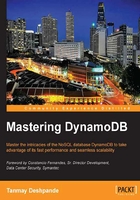
Conventions
In this book, you will find a number of styles of text that distinguish between different kinds of information. Here are some examples of these styles, and an explanation of their meaning.
Code words in text, database table names, folder names, filenames, file extensions, pathnames, dummy URLs, user input, and Twitter handles are shown as follows: "This configuration option allows us to set the maximum number of times HttpClient should retry sending the request to DynamoDB."
A block of code is set as follows:
// Create a configuration objectfinal ClientConfiguration cfg = new ClientConfiguration();// Set the maximum auto-reties to 3cfg.setMaxErrorRetry(3);
// Set configuration object in Clientclient.setConfiguration(cfg);
When we wish to draw your attention to a particular part of a code block, the relevant lines or items are set in bold:
AmazonDynamoDBClient client = new AmazonDynamoDBClient(); // Set geo table in configuration GeoDataManagerConfiguration geoDataManagerConfiguration = new GeoDataManagerConfiguration( client, "geo-table"); // Create Geo data manager GeoDataManager geoDataManager = new GeoDataManager(geoDataManagerConfiguration);
Any command-line input or output is written as follows:
mvn clean install -Dgpg.skip=true
New terms and important words are shown in bold. Words that you see on the screen, in menus or dialog boxes for example, appear in the text like this: "You can click on Continue to move ahead."
Note
Warnings or important notes appear in a box like this.
Tip
Tips and tricks appear like this.